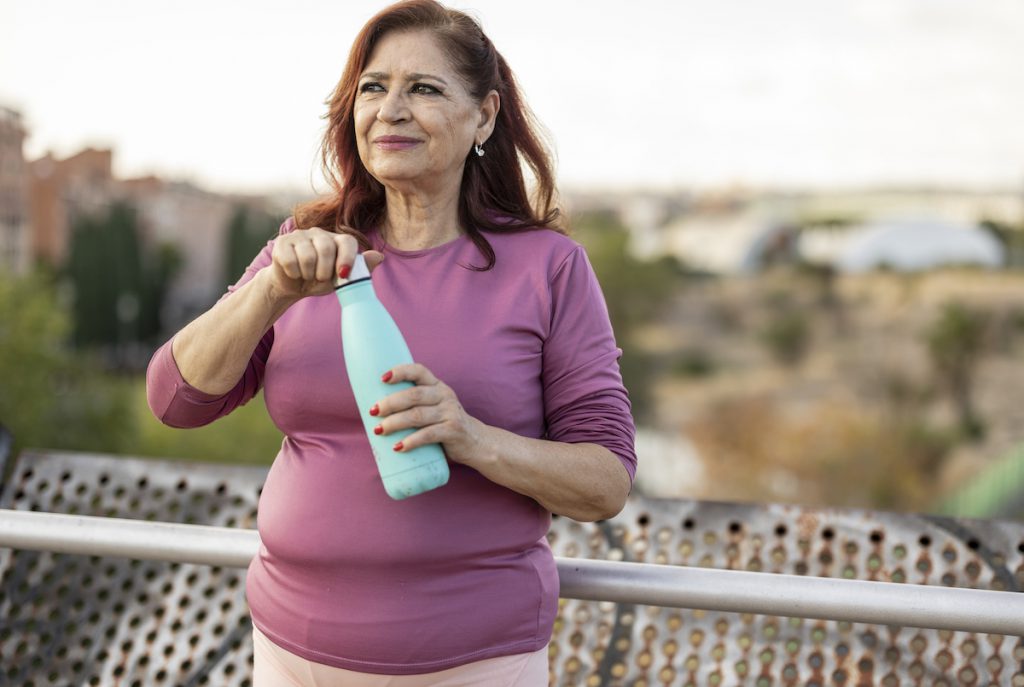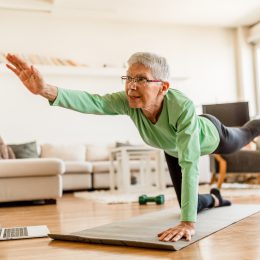8 Top Questions About Belly Fat, Answered
Belly fat doesn’t just affect how your clothes fit. Too much of it can put you at higher risk for certain diseases, even if you’re at a healthy weight.

Much like dust bunnies under the bed, belly fat accumulates over time. Research has found that visceral fat — the kind that collects in our midsections and surrounds our organs — doubles for men between ages 25 and 65 and quadruples for women.
And it’s not just about how we may not like how we look in the mirror anymore. Too much visceral fat can raise our risk for many diseases, including cardiovascular disease, type 2 diabetes, and breast cancer.
“Fat is not sitting there doing nothing,” explains Sriram Machineni, M.D., director of the Fleischer Institute Medical Weight Center at the Albert Einstein College of Medicine. “It’s a metabolically active tissue, producing about 600 hormones and substances.”
Here’s what you need to know about belly fat, and how you can whittle it down for better health.
Stay active, have fun, get fit — with SilverSneakers! Classes and events are happening right now at participating gyms, online through SilverSneakers LIVE, and at community centers near you. Activate your free online account to get started.
What is belly fat?
Belly fat is fat tissue that is deposited in the midsection of our bodies. There are two different types of it, and the health risk largely depends on which kind it is.
Subcutaneous fat. This is the type of belly fat you can see and pinch with your fingers. It sits between your skin and abdominal muscles. Although people may moan about it, subcutaneous belly fat may be more neutral to our health than harmful.
In other areas of the body, such as the hips and thighs, this type of fat secretes adiponectin, a hormone that benefits cardiovascular and metabolic health, says Dr. Machineni. It’s unclear at this time, however, whether subcutaneous belly fat offers similar benefits.
Visceral fat. This second fat type is the one that can cause trouble — even if it’s not the one we can see or touch. Visceral fat hides deep in the abdomen, nestled against your stomach, liver, intestines, and other organs.
Unlike subcutaneous fat, visceral fat produces hormones and substances that can lead to chronic, low-level inflammation, says Dr. Machineni, as well as other serious health conditions (see below).
What role does belly fat play in my overall health?
As we age, body fat distribution tends to shift, especially for women. In addition to moving up from the hips to the belly, it also tends to move inward, from subcutaneous to visceral, says Dr. Machineni.
That means levels of protective adiponectin drop and health risks rise. This boosts your odds for many of the so-called diseases of aging, including:
- Type 2 diabetes
- Heart disease and stroke
- Breast cancer and colon cancer
- Gallbladder problems
- Elevated cholesterol levels
- Insulin resistance
- Alzheimer’s disease
How do I measure my belly fat?
The best way to measure your belly fat is with a tape measure. Keep it level with your belly button while you check the circumference of your waist. For women, 35 inches or more means you’re at risk for health problems. For men, that number is 40 inches or more.
If you want to gauge your visceral fat specifically, there are ways you can guesstimate that. Visceral fat makes up about 10 percent of your body fat. You can determine your visceral fat level by calculating your total body fat percentage. You can do that with an online calculator or having your doctor check you with skinfold calipers. So, 10 percent of that total percentage is visceral fat.
Do I need to worry about belly fat if I’m at a healthy weight?
Unfortunately, yes. That’s because you can’t see or pinch the dangerous kind of belly fat. Your scale weight and waist circumference could be considered healthy. Yet, your amount of visceral fat could still be dangerously high, says Machineni.
On top of that, muscle mass declines with age. When coupled with a rise in visceral fat, this can lead to a condition known as sarcopenic obesity, or what some people call “skinny fat.” Sarcopenic obesity has been linked to physical disability, heart disease, insulin resistance, and an increased risk of premature death.
Can exercise help me lose visceral fat?
It absolutely can. Physical activity is particularly effective at helping people lose belly fat, especially the dangerous visceral type. And it can start to disappear right away. “Normally the first place people lose fat is in the visceral area,” says Logan Strollis, MS, an exercise physiologist at Lehigh Valley Health Network Fitness, in Allentown, Pennsylvania.
When you exercise regularly, you’ll:
- Build and maintain muscle. It’s thought that the slow loss of muscle tissue over time is responsible for 25 percent of the visceral fat that people gain throughout adulthood. Strength training helps to reverse that trend.
- Improve insulin sensitivity. When overweight or obese people exercised five days a week for six months, their visceral belly fat shrunk by up to 20 percent and insulin sensitivity improved 26 percent, according to a 2019 study published in the British Medical Journal.
- Burn more calories through daily movement. When you’re in better shape from regular exercise, the activities of daily living feel easier, says Strollis. That means you’ll likely move around more, which can help you burn off even more visceral fat.
Recommended reading: Functional Fitness: The SilverSneakers Guide
What are the best exercises to lose belly fat?
Strollis says the proven winner for burning belly fat is combining cardiovascular exercise with strength training. (Remember to get your doctor’s OK before beginning any new exercise program.)
You should aim for:
- Two days a week of moderate-intensity strength training that targets all of the major muscle groups
- 150-weekly minutes of moderate intensity cardio or 75-weekly minutes of vigorous intensity cardio.
If you’re just getting started, 150 minutes per week might feel like too much, says Strollis. So work up to that amount over time. “Even slight increases in activity are better than staying sedentary,” he says.
Recommended class: SilverSneakers Circuit. This standing class alternates upper-body strength work with low-impact cardio to maximize fitness benefits. A chair and handheld weights or tubing are recommended. It’s offered both in-person (review the gym’s schedule for current times) and online with SilverSneakers LIVE.
Press play to try a 15-minute workout reduce belly fat:
What other lifestyle behaviors target belly fat?
The same behavioral lifestyle choices that improve overall health will also help you to reduce belly fat, says Dr. Machineni. Focus on improving these specific areas:
Subscribe to our newsletter
It's quick and easy. You could be one of the 13 million people who are eligible.
Already a member? Click to discover our 15,000+ participating locations.
Follow Us
Eat a healthy diet. Focus on eating more minimally-processed whole foods, including colorful fruits and vegetables, legumes, fish, poultry, nuts and seeds, and whole grains. At the same time, cut back on highly processed packaged foods, fried foods, and sugar-sweetened foods.
Recommended reading: Healthy Eating for Older Adults: The SilverSneakers Guide
Manage your stress. Higher levels of the stress hormone cortisol are associated with higher amounts of visceral fat. Stress, boredom, and negative emotions can also lead to poor eating choices (hello there, snack chips and packaged cookies).
That said, try not to stress yourself out over how stressed you feel, says Janet Boseovski, Ph.D., a professor of psychology at the University of North Carolina Greensboro. Easier said than done, yes, but your body will thank you for the effort.
Recommended reading: Anxiety in Older Adults: What You Need to Know
Improve your sleep. When we sleep poorly, hunger and cravings go up, while the desire to exercise slips away. Sleep patterns change with age, and many people who used to drift off easily find themselves struggling to fall or stay asleep.
As with stress management, try not to obsess over your sleep, as it can make it even harder to drift off. Instead, brainstorm ways to relax in the 30 to 60 minutes before bed, suggests Dr. Machineni. Turning off all electronics, reading a calming book, and meditating can all help.
Recommended reading: Take the 7-Day Sleep Challenge
Do I need to follow a low-fat or low-carb diet if I’m trying to lose belly fat?
The science isn’t conclusive enough to know. Some research touts low-fat diets as the key to losing belly fat. But you’ll also find studies linking low-carb diets to improved belly fat levels. And, to confuse matters even more, there’s research that finds no real difference between the two dietary styles.
For these reasons, Dr. Machineni recommends focusing on the whole foods you put on your plate rather than counting fat or carb grams. Try to follow a Mediterranean-style diet that is rich in minimally-processed foods, fiber, and lean protein. This is especially true for people who are older than 65, as this eating pattern not only helps reduce dangerous belly fat, but also drives down risk for nearly every kind of disease.
Recommended reading: 10 Dos and Don’ts to Lose Belly Fat After 65
See our sources:
Age and belly fat: International Journal of Body Composition Research
Visceral fat and disease risk: Harvard Health Publishing
Adinopenectin: Circulation Research
Dangers of visceral fat: Biochim Biophys Acta
Exercise and visceral fat: International Journal of Body Composition Research (2014): Age related shift in visceral fat





